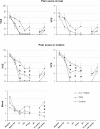Peridural Anesthesia or Ultrasound-Guided Continuous 3-in-1 Block: Which Is Indicated for Analgesia in Very Elderly Patients With Hip Fracture in the Emergency Department?
- PMID: 23569705
- PMCID: PMC3598445
- DOI: 10.1177/2151458512470953
Peridural Anesthesia or Ultrasound-Guided Continuous 3-in-1 Block: Which Is Indicated for Analgesia in Very Elderly Patients With Hip Fracture in the Emergency Department?
Abstract
Purpose: The aim of our study was to investigate the clinical relevance of preoperative acute pain management and cardiovascular stability by ultrasound-guided continuous 3-in-1 nerve block in very elderly patients with hip fracture when compared to epidural anesthesia (PDA).
Methods: To study the analgesic effect, we enrolled 37 very elderly patients with hip fractures, of whom 3 patients with dementia had to be excluded. Thus, 34 patients were randomized to 1 of the 3 groups: group A (ultrasound-guided continuous 3-in-1 block, bupivacaine; n = 10, dropout rate: 0), group B (PDA, bupivacaine; n = 14, dropout rate: 8), and group C (systemic pain therapy, piritramide/paracetamol; n = 10, dropout rate: 0). Pain intensity was assessed preoperatively and up to 24 hours postoperatively using a visual analog scale, verbal rating scale, analgesic consumption, scale of well-being, and cardiocirculatory parameters (eg, serum troponin T).
Results: Our data show that in the preoperative period both regional anesthesia (RA) procedures (analgesia responders after 1 hour: 86.7% and 100%; P = .001) were superior to systemic analgesia (analgesia responders: 46.7%), and the rescue medication requirement in the 2 RA groups was significantly lower (P = .02). Serum troponin T level increased only in the systemic analgesia group (P = .04). In the emergency department, the disadvantage of PDA in geriatric patients with hip fracture was the fact that procedures were more complex, resulting in a high dropout rate (57.1%). The use of PDA has to be critically discussed for ethical concerns.
Conclusion: In the specific situation of acute hospital admission, the ultrasound-guided continuous 3-in-1 block appears to be indicated as a stress-free means of providing adequate preoperative pain relief in very elderly patients with hip fracture. However, these findings should be corroborated by studies involving larger numbers of patients.
Keywords: analgesia; emergency; geriatrics; serum troponin T; ultrasound-guided continuous 3-in-1 block.
Conflict of interest statement
Figures


References
-
- Kammerlander C, Roth T, Friedman SM, et al. Ortho-geriatric service – a literature review comparing different models. Osteoporos Int. 2010;21(suppl 4):S637–S646 - PubMed
-
- Friedman S, Mendelson D, Kates S, McCann R. Geriatric co-management of proximal femur fractures: total quality management and protocol-driven care result in better outcomes for a frail patient population. J Am Geriatr Soc. 2008;56(7):1349–1356 - PubMed
-
- Luger TJ, Kammerlander C, Gosch M, et al. Neuroaxial versus general anaesthesia in geriatric patients for hip fracture surgery: does it matter? Osteoporos Int. 2010;21(suppl 4):S555–S572 - PubMed
LinkOut - more resources
Full Text Sources

